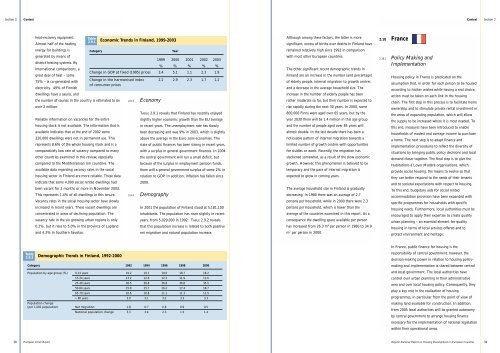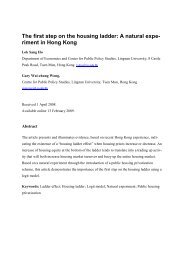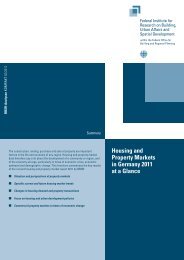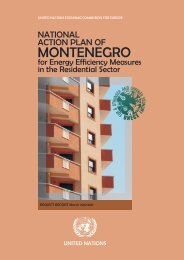housing developments in european countries - Department of ...
housing developments in european countries - Department of ...
housing developments in european countries - Department of ...
You also want an ePaper? Increase the reach of your titles
YUMPU automatically turns print PDFs into web optimized ePapers that Google loves.
Section 2<br />
Context<br />
Context Section 2<br />
heat-recovery equipment. Table<br />
Almost half <strong>of</strong> the heat<strong>in</strong>g<br />
2.9.1 Economic Trends <strong>in</strong> F<strong>in</strong>land, 1999-2003<br />
energy for build<strong>in</strong>gs is<br />
generated by means <strong>of</strong><br />
Category<br />
Year<br />
1999 2000 2001 2002 2003<br />
district heat<strong>in</strong>g systems. By<br />
% % % % %<br />
<strong>in</strong>ternational comparisons, a<br />
Change <strong>in</strong> GDP at fixed (1995) prices 3.4 5.1 1.1 2.3 1.9<br />
great deal <strong>of</strong> heat – some<br />
75% – is co-generated with<br />
electricity. 49% <strong>of</strong> F<strong>in</strong>nish<br />
dwell<strong>in</strong>gs have a sauna, and<br />
Change <strong>in</strong> the harmonised <strong>in</strong>dex<br />
<strong>of</strong> consumer prices<br />
2.2 2.9 2.3 1.7 1.2<br />
the number <strong>of</strong> saunas <strong>in</strong> the country is estimated to be<br />
over 2 million.<br />
Reliable <strong>in</strong>formation on vacancies for the entire<br />
<strong>hous<strong>in</strong>g</strong> stock is not available. The <strong>in</strong>formation that is<br />
available <strong>in</strong>dicates that at the end <strong>of</strong> 2002 some<br />
220,000 dwell<strong>in</strong>gs were not <strong>in</strong> permanent use. This<br />
represents 8.6% <strong>of</strong> the whole <strong>hous<strong>in</strong>g</strong> stock and is a<br />
comparatively low rate <strong>of</strong> vacancy compared to many<br />
other <strong>countries</strong> exam<strong>in</strong>ed <strong>in</strong> this review, especially<br />
compared to the Mediterranean rim <strong>countries</strong>. The<br />
available data regard<strong>in</strong>g vacancy rates <strong>in</strong> the social<br />
<strong>hous<strong>in</strong>g</strong> sector <strong>in</strong> F<strong>in</strong>land are more reliable. These data<br />
<strong>in</strong>dicate that some 4,000 social rented dwell<strong>in</strong>gs had<br />
2.9.3 Economy<br />
TABLE 2.9.1 reveals that F<strong>in</strong>land has recently enjoyed<br />
slightly higher economic growth than the EU average<br />
<strong>in</strong> recent years. The unemployment rate has slowly<br />
been decreas<strong>in</strong>g and was 9% <strong>in</strong> 2003, which is slightly<br />
above the average <strong>in</strong> the Euro zone economies. The<br />
state <strong>of</strong> public f<strong>in</strong>ances has been strong <strong>in</strong> recent years,<br />
with a surplus <strong>in</strong> general government f<strong>in</strong>ances. In 2004<br />
the central government will run a small deficit, but<br />
because <strong>of</strong> the surplus <strong>in</strong> employment pension funds,<br />
there will a general government surplus <strong>of</strong> some 2% <strong>in</strong><br />
relation to GDP. In addition, <strong>in</strong>flation has fallen s<strong>in</strong>ce<br />
2000.<br />
been vacant for 2 months or more <strong>in</strong> November 2003.<br />
This represents 1.4% <strong>of</strong> all dwell<strong>in</strong>gs <strong>in</strong> this tenure.<br />
Vacancy rates <strong>in</strong> the social <strong>hous<strong>in</strong>g</strong> sector have slowly<br />
<strong>in</strong>creased <strong>in</strong> recent years. These vacant dwell<strong>in</strong>gs are<br />
concentrated <strong>in</strong> areas <strong>of</strong> decl<strong>in</strong><strong>in</strong>g population. The<br />
vacancy rate <strong>in</strong> the six grow<strong>in</strong>g urban regions is only<br />
0.2%, but it rises to 5.0% <strong>in</strong> the prov<strong>in</strong>ce <strong>of</strong> Lapland<br />
and 4.3% <strong>in</strong> Southern Savolax.<br />
2.9.4 Demography<br />
In 2001 the population <strong>of</strong> F<strong>in</strong>land stood at 5,181,100<br />
<strong>in</strong>habitants. The population has risen slightly <strong>in</strong> recent<br />
years, from 5,029,000 <strong>in</strong> 1992. TABLE 2.9.2 reveals<br />
that this population <strong>in</strong>crease is related to both positive<br />
net migration and natural population <strong>in</strong>crease.<br />
Although among these factors, the latter is more<br />
significant, excess <strong>of</strong> births over deaths <strong>in</strong> F<strong>in</strong>land have<br />
rema<strong>in</strong>ed relatively high s<strong>in</strong>ce 1992 <strong>in</strong> comparison<br />
with most other European <strong>countries</strong>.<br />
The other significant recent demographic trends <strong>in</strong><br />
F<strong>in</strong>land are an <strong>in</strong>crease <strong>in</strong> the number (and percentage)<br />
<strong>of</strong> elderly people, <strong>in</strong>ternal migration to growth centres<br />
and a decrease <strong>in</strong> the average household size. The<br />
<strong>in</strong>crease <strong>in</strong> the number <strong>of</strong> elderly people has been<br />
rather moderate so far, but their number is expected to<br />
rise rapidly dur<strong>in</strong>g the next 30 years. In 2000, some<br />
800,000 F<strong>in</strong>ns were aged over 65 years, but by the<br />
year 2030 there will be 1.4 million <strong>in</strong> this age group<br />
and the number <strong>of</strong> people aged over 85 years will<br />
almost double. In the last decade there has been a<br />
noticeable pattern <strong>of</strong> <strong>in</strong>ternal migration towards a<br />
limited number <strong>of</strong> growth centres with opportunities<br />
for studies or work. Recently, the migration has<br />
slackened somewhat, as a result <strong>of</strong> the slow economic<br />
growth. However, this phenomenon is believed to be<br />
temporary and the pace <strong>of</strong> <strong>in</strong>ternal migration is<br />
expected to grow <strong>in</strong> com<strong>in</strong>g years.<br />
The average household size <strong>in</strong> F<strong>in</strong>land is gradually<br />
decreas<strong>in</strong>g. In 1980 there was an average <strong>of</strong> 2.7<br />
persons per household, while <strong>in</strong> 2000 there were 2.3<br />
persons per household, which is lower than the<br />
average <strong>of</strong> the <strong>countries</strong> exam<strong>in</strong>ed <strong>in</strong> this report. As a<br />
consequence the dwell<strong>in</strong>g space available per person<br />
has <strong>in</strong>creased from 26.3 m 2 per person <strong>in</strong> 1980 to 34.9<br />
m 2 per person <strong>in</strong> 2000.<br />
2.10 France<br />
2.10.1 Policy Mak<strong>in</strong>g and<br />
Implementation<br />
Hous<strong>in</strong>g policy <strong>in</strong> France is predicated on the<br />
assumption that, <strong>in</strong> order for each person to be housed<br />
accord<strong>in</strong>g to his/her wishes while hav<strong>in</strong>g a real choice,<br />
action must be taken on each l<strong>in</strong>k <strong>in</strong> the <strong>hous<strong>in</strong>g</strong><br />
cha<strong>in</strong>. The first step <strong>in</strong> this process is to facilitate home<br />
ownership and to stimulate private rental <strong>in</strong>vestment <strong>in</strong><br />
the areas <strong>of</strong> expand<strong>in</strong>g population, which will allow<br />
the supply to be <strong>in</strong>creased where it is most needed. To<br />
this end, measures have been <strong>in</strong>troduced to enable<br />
households <strong>of</strong> modest and average <strong>in</strong>come to purchase<br />
a home. The next step is to adapt f<strong>in</strong>ance and<br />
implementation procedures to reflect the diversity <strong>of</strong><br />
situations by br<strong>in</strong>g<strong>in</strong>g public policy decisions and local<br />
demand closer together. The f<strong>in</strong>al step is to give the<br />
Habitations à Loyer Modéré organisations, which<br />
provide social <strong>hous<strong>in</strong>g</strong>, the means to evolve so that<br />
they can better respond to the needs <strong>of</strong> their tenants<br />
and to societal expectations with respect to <strong>hous<strong>in</strong>g</strong>.<br />
To this end, budgetary aids for social rented<br />
accommodation provision have been expanded with<br />
specific programmes for households with specific<br />
<strong>hous<strong>in</strong>g</strong> needs. Furthermore, local authorities must be<br />
encouraged to apply their expertise to create quality<br />
urban plann<strong>in</strong>g – an essential element for quality<br />
<strong>hous<strong>in</strong>g</strong> <strong>in</strong> terms <strong>of</strong> local services <strong>of</strong>fered and to<br />
protect environment and heritage.<br />
Table<br />
2.9.2<br />
Demographic Trends <strong>in</strong> F<strong>in</strong>land, 1992-2000<br />
Category 1992 1994 1996 1998 2000<br />
Population by age group (%) 0-14 years 19.2 19.1 19.0 18.7 18.2<br />
15-24 years 13.2 12.6 12.3 11.9 11.6<br />
25-49 years 38.5 38.8 36.8 36.8 35.5<br />
50-64 years 15.9 15.7 16.2 17.4 18.7<br />
65-79 years 10.6 10.8 11.1 11.3 11.5<br />
> 80 years 3.0 3.1 3.2 3.3 3.3<br />
Population change<br />
(per 1,000 population) Net migration 1.8 0.7 0.8 0.9 0.5<br />
National population change 3.3 3.4 2.3 1.5 1.4<br />
In France, public f<strong>in</strong>ance for <strong>hous<strong>in</strong>g</strong> is the<br />
responsibility <strong>of</strong> central government; however, the<br />
decision-mak<strong>in</strong>g power <strong>in</strong> relation to <strong>hous<strong>in</strong>g</strong> policymak<strong>in</strong>g<br />
and implementation is shared between central<br />
and local government. The local authorities have<br />
control over urban plann<strong>in</strong>g <strong>in</strong> their adm<strong>in</strong>istrative<br />
area and over local <strong>hous<strong>in</strong>g</strong> policy. Consequently, they<br />
play a key role <strong>in</strong> the realisation <strong>of</strong> <strong>hous<strong>in</strong>g</strong><br />
programmes, <strong>in</strong> particular from the po<strong>in</strong>t <strong>of</strong> view <strong>of</strong><br />
mak<strong>in</strong>g land available for construction. In addition,<br />
from 2005 local authorities will be granted autonomy<br />
by central government to arrange <strong>hous<strong>in</strong>g</strong> f<strong>in</strong>ance<br />
necessary for the implementation <strong>of</strong> national legislation<br />
with<strong>in</strong> their operational areas.<br />
38 European Union Report<br />
Regular National Report on Hous<strong>in</strong>g Developments <strong>in</strong> European Countries<br />
39

















